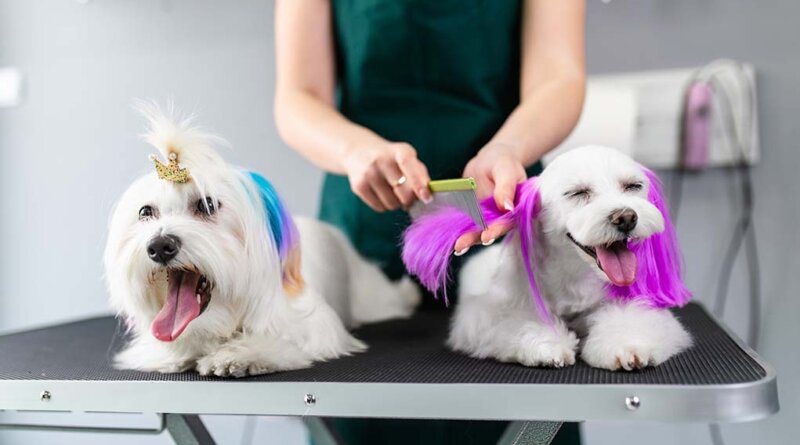What You Must Know About It
There has always been a fascination among some pet owners about dressing dogs in stylish clothes, and keeping pets included in the same trends that owners follow.
As the pet industry expanded, we’ve moved past clothing alone, and now that also includes hair curlers, temporary tattoos, bows and bandanas, and dog fur dye.
Dying the hair of dogs is not a new trend, but rather the one that’s coming back.
Before jumping on the bandwagon, there are many things you must consider, especially the safety of these chemicals and their effect on dogs’ skin and coat.
Generally, veterinarians and dog experts do not recommend using dog fur dye in any shape or form, but for pet owners who choose it anyway, know that some products are safer than others.
Make sure that you are familiar with the specific ingredients in the dog fur dye product, the process to properly and safely dye your dog’s hair, and keeping your pooch and their skin and coat away from harm during the whole process.
If you are familiar with all the possibilities, you are more likely to be able to dye your dog’s hair (or better yet, decide not to do that) without harming your pup.
Dog Hair Dye That Is Safe
Not all dog hair dye is safe for use on pets, especially hair dye that is made for humans.
Hair dyes are filled with ingredients that may be toxic to dogs and, at best, can permanently damage their fur and skin, while at worst, potentially cause short-term and long-term health issues, including death if the dog licks the toxic product.
There are a few brands that are specifically meant for use in dogs (mentioned below), and these are your best options.

Stay away from things like P-phenylenediamine, Resorcinol, Lead acetate, and Toluene.
A good rule of thumb is to stick to dog fur dye brands like Top Performance or Owpawz that meet the standards of the Personal Care Products Council, or P.C.P.C, which sets the safety standards and recommends certain pet products based on their analysis of ingredients.
Natural Dog Fur Dye
Before pet fur dying was mainstream, owners came up with natural ways to dye their pet’s fur.
These natural methods are much safer and less damaging to the dog’s skin, fur, and overall health.
Most were created from materials found around the home and products found within the kitchen.
Drink mixes have been used, but are only safe for use if they do not contain sugar which can irritate a dog’s skin and encourage them to lick and pose a poisoning threat.
It is also challenging to achieve the desired color and is very temporary.
Food dye has also been used when it is diluted and applied with a spray bottle.
Is Manic Panic Safe for Dogs?
A choice that is not found casually around the home, but is an all-natural dog fur dye solution is the brand Manic Panic.
They are vegetable-based hair dye that is intended for use on people but can be used on pets.
It is safe for use due to its chemical-free composition.
The Manic Panic brand works better on certain canine coat types than others and the length of time it remains varies by individual use.
A Dog’s Safety With Hair Dye for Dogs

However, taking your dog to a professional groomer rather than trying to dye dog’s hair at home is preferable.
A groomer has to be trained to properly apply dog hair dye, preventing and dealing with any issues that may arise during the process.
When dying a dog’s hair, there are always a few risks, such as the possibility of your dog having an allergic reaction to the dye.
Professional groomers can handle the situation and are more likely to have access to safe products rather than whatever seems to be safe at the store.
If attempting to dye your dog’s fur at home, you run the risk of also dying your towels, walls, carpet, ceiling, and yourself.
Avoid using any products that contain bleach, ammonia, or other harsh chemicals that are not safe for pet consumption, whether it is advertised as safe or not.
A few other dog fur dye brands that are generally used by professional groomers are:
Tips for Dying Dog’s Hair
Keeping your dog safe and trying to dye their fur at the same time can be difficult, especially when you’re not sure what is dangerous and what is not, or how to properly apply the dye.
Here are a few tips and tricks to help you throughout the process:
Labels
Always read the dog fur dye product’s label before attempting to use it.
You will get better results and be more familiar with any safety concerns surrounding it.
Take warning labels seriously as there is a reason that they are added to the bottle.
Skin Condition
If your dog is predisposed to sensitive skin or tend to suffer from skin allergies, then they should not be dyed; neither should dogs with damaged skin or any type of skin irritation or condition.
If allergies are the only concern, you can try an allergy test on a small portion of the skin, but consult with a groomer first.
Test First
Even if the dog is not predisposed to skin allergies, always make sure to test a small portion of dug hair dye beforehand.
Although your dog may not be sensitive, there are chemicals included that pets are not commonly exposed to and may have an adverse reaction.
Protect The Face
Never allow the product to come into contact with your dog’s eyes.
Avoid dying your pet’s face altogether. If you are going to dye their faces, use a cotton ball to prevent any mistakes or mishandling that could lead to dye entering their eyes, but it’s generally not recommended, at least allow a groomer do it.
Time
Some products are required to be left on for fifteen minutes or longer.
Make sure you are prepared to spend that time with the dog to prevent them from messing with the dye or shaking the dye off.
Toxic Chemicals
Never use products with chemicals that are intended for use on humans.
Most ingredients included in human hair dye are too strong and can be damaging to dogs’ skin and fur, and potentially lethal even without having to be ingested.
If a product is advertised as non-toxic, still be cautious because if it is non-toxic to humans, it’s not necessarily non-toxic to dogs.
Dying your dog’s fur should not be a decision that you make lightly, especially when there are chemicals involved that can potentially damage a pet’s skin and coat, cause allergies, and other issues.
If possible, consult with a veterinarian and groomer before you attempt this.
Use only dog-specific hair dyes with non-toxic ingredients from trusted brands, and take proper steps and follow guidelines to guarantee your dog’s health and safety.
READ NEXT: 9 Ways to Improve Your Dog’s Skin and Coat Health
Disclosure: We may earn affiliate commissions at no cost to you from the links on this page. This did not affect our assessment of products. Read more here and find full disclosure here.
Related




